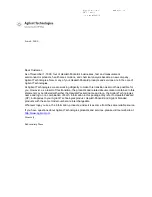
©
2017 Sensata Technologies
Page 40
Maintenance and Troubleshooting
Symptom
Possible Cause
Recommended Solution
No output power.
Inverter LED is
OFF. (Cont.)
Battery voltage is too high. The
inverter automatically resets and
resumes operation when the battery
voltage drops to the HBCI voltage or
lower.
Condition usually only occurs when an
additional charging source (external charging
sources) is used to charge the battery bank.
Reduce/turn off any other charger to the
inverter batteries to allow voltage level to drop.
Over-temperature condition: The
internal temp of the inverter has
risen above acceptable limits;
caused by loads too great for the
inverter to operate continuously, or
by lack of ventilation to the inverter.
When unit cools, it will automatically
reset and resume operation.
Reduce the number of electrical loads that you
are operating, this will avoid a repeat over-
temp shutdown if the cause was too many
loads for the ambient conditions.
Check ventilation around inverter, ensure cool
air is available to pass-thru the inverter (refer
to ventilation requirements in Section 2.1.3).
AC overload condition: The
inverter has turned off because the
connected loads are larger than the
inverter’s output capacity, or the
output wires are shorted.
Reduce the AC loads connected to the inverter,
or remove all AC output wiring and restart the
inverter.
Internal fault: This fault occurs when
an internal fault is detected.
To clear this fault, a power or inverter reset
is required—see Section 4.4. If this fault does
not clear or returns, the unit needs servicing.
No output power.
a) Green LED is
fl
ashing (x1/sec).
b) Green LED
fl
ashing rapidly
(
fl
utters).
a) Unit is in Search mode, which
means load is too small for Search
mode circuit detection.
a) Turn on a load greater than 5 watts to bring
inverter out of search, or turn off search with
remote.
b) Unit is in reset.
b) Perform a power or inverter reset—see
Section 4.4. If fault continues, unit needs to be
serviced.
Low output or
surge power
when inverting.
Loose or corroded battery cables.
Clean and tighten all cables.
Low batteries.
Recharge or replace batteries.
Loose AC output connections.
Tighten AC output connections.
Battery cables are the wrong length
or gauge.
Verify recommended cable lengths and gauges
from the manual. Replace cables as necessary.
Low charging
rate (connected
to AC power).
Charge rate set too low.
Adjust charge rate or SHORE settings on
remote.
Low AC voltage (<90 VAC).
Check AC input wiring.
Low charging
rate (using
generator).
Generator output is too low to power
both load and charger.
Reduce load, increase the generator’s RPMs.
Check SHORE settings (if remote connected).
Charger does not
charge.
Loose or corroded battery cables.
Clean and tighten battery cables.
Defective batteries.
Replace batteries.
Wrong charger settings.
Adjust the charger settings, ensure the unit is
not in charger standby.
Wrong AC input voltage.
Verify proper AC input voltage and frequency.
Inverter AC
output voltage
is too low or too
high when using
an AC voltmeter.
Wrong type of voltmeter used
(will display 90 VAC to 130 VAC
depending on the battery voltage).
Most meters are made to read Average
AC voltage. The AC output of the ME is a
“modi
fi
ed” waveform which requires using a
“true” RMS voltmeter to correctly read the
output voltage.
While charging,
DC charge
voltage is
higher/lower
than expected.
If the Battery Temperature Sensor
(BTS) is installed, the DC voltage
will increase or decrease depending
on the temperature around the BTS.
This is normal; see Section 3.5 (Battery
Temperature Sensor Operation) for more
information.














































